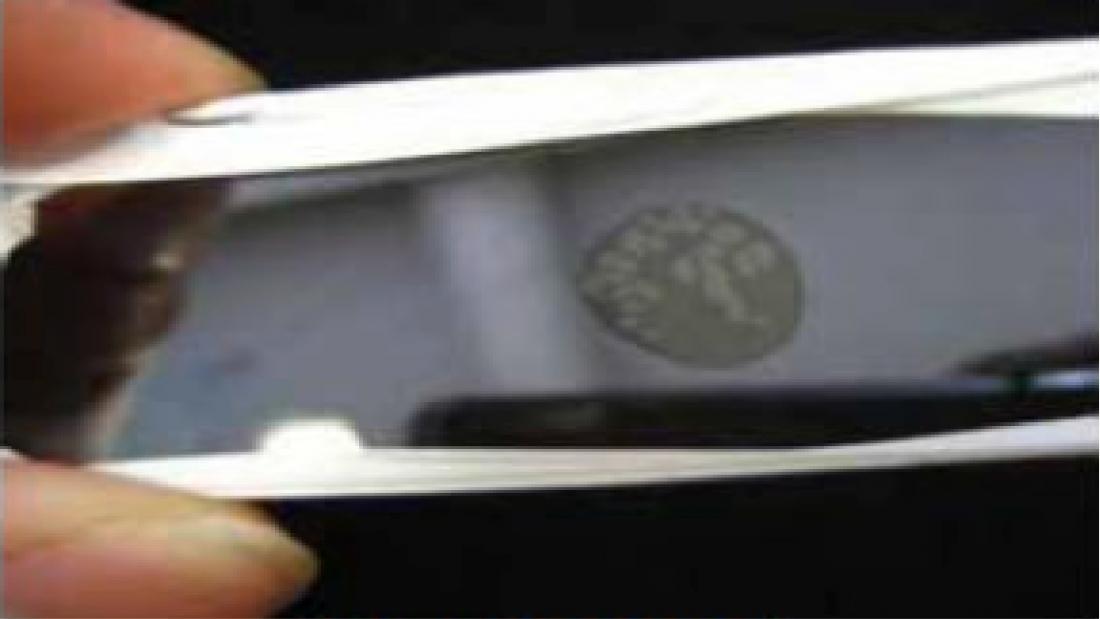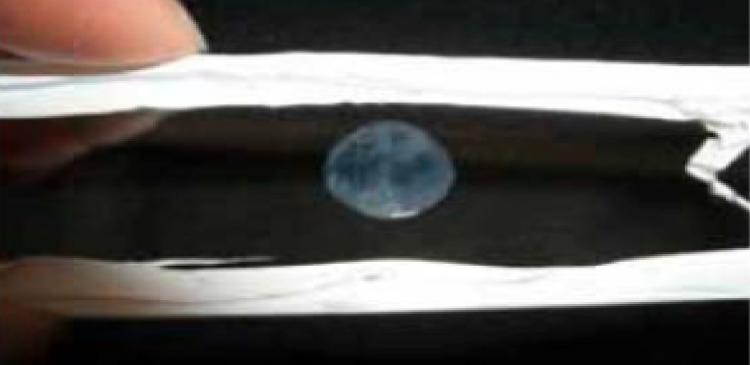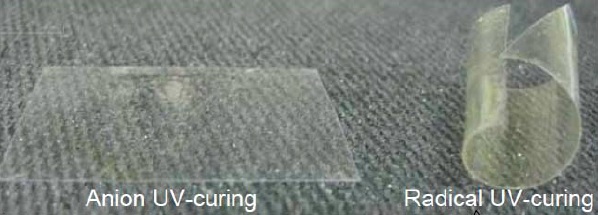1. UV curing sample using a conventional photobase generator that produces carbon dioxide. Gas bubbles are produced
Background
In terms of their curing mechanisms, UV curing materials are divided into three types: radical, cationic and anionic UV curing materials. Currently, radical UV curing is the most used for practical applications, with some cationic UV curing also utilized. Due to inhibition by the oxygen in air, radical UV curing readily gives rise to curing defects, and adherence to the substrate is poor. Furthermore, while cationic curing is not subject to inhibition by the oxygen in air, and gives comparatively good adherence to the substrate, it uses strong acid as a catalyst, which gives rise to the problem of metal corrosion. In contrast, although anionic UV curing has the potential ability to avoid the defects of both radical and cationic curing, it is not used practically because of its poor efficiency as a
photobase generator, and has received extremely little attention.
Results
Several photobase generators producing aliphatic amines are currently known, but practical adoption of anionic UV curing and photo-patterning materials, etc. as photosensitive materials has been difficult, not only because of the low efficiency of light triggered base production, but also because—together with the base—carbon dioxide is also generated. Therefore, in order to improve the efficiency of base generation, the Arimitsu Laboratory began by developing—for the first time—a new photo-amine generator that uses a ketoprofen high efficiency photo-decarburization reaction, succeeding in the creation of a high sensitivity photopolymer (presented on May 26, 2005 at the 54th Annual Meeting of the Society of Polymer Science, Japan (SPSJ)).
Subsequently, this ketoprofen derivative was developed into a photobase generator that produces strong bases.
In addition, as a photobase generation reaction that is not accompanied by the production of carbon dioxide, we focused attention on the photocyclization reaction of coumaric acid derivatives, applying them as a high efficiency photobase generator to photopolymers for the first time, and successfully demonstrating their effectiveness (presented on September 19, 2007 at the 56th Symposium on Macromolecules, SPSJ). Furthermore, as compounds that enable a photobase generation reaction of strong bases without the production of carbon dioxide, we focused attention on 2-alkenylbenzoic acid derivatives, and were the first in the world to succeed in developing a corresponding new photobase generator that produces strong bases (presented on May 26, 2011 at the 60th SPSJ Annual Meeting). Since the high efficiency photochemical generation of strong bases is now possible, the sensitivity of photopolymers has dramatically increased.
Future Expectations
We have already applied for patents for these photopolymers containing photobase generators, and it is strongly expected that they will be used in a wide variety of fields, as adhesives, encapsulants, ink, paint, various coatings and in photo-patterning, etc. These photobase generators are scheduled to be sold nationwide by Wako Pure Chemical Industries, Ltd.
---------------------------------------------------------------------
Contact Information
Inquiries regarding this press release should be made to below:
Arimitsu Laboratory
Department of Pure and Applied Chemistry, Faculty of Science and Technology,
Tokyo University of Science
E-mail: [email protected]
Tel: +81-4-7122-1618 Fax: +81-4-7123-9890





